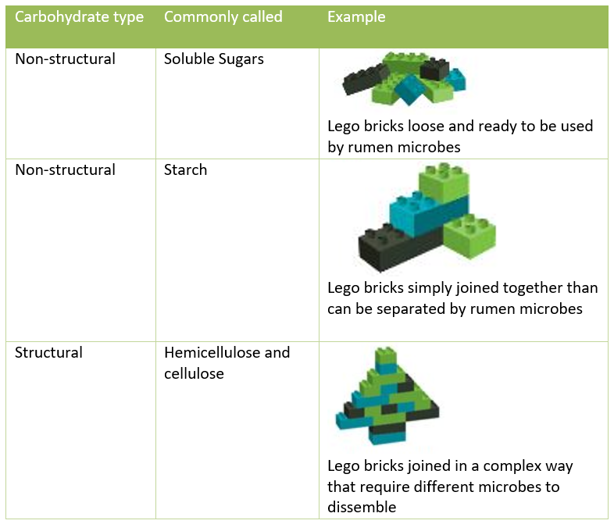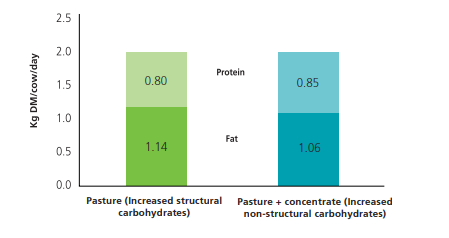Carbohydrate
2 min read
Carbohydrates, forming about 75% of plant dry matter, provide the major energy source for dairy cows and aid in milk glucose and fat production. This page unpacks the two main types: structural carbohydrates, which are part of the plant cell wall, and non-structural carbohydrates found within the plant cell. It explains how different carbohydrate sources affect the energy generated from microbial fermentation in the rumen, emphasising that the total energy supplied matters more than the carbohydrate source. The page also highlights the importance of managing pastures properly to maintain high digestibility of carbohydrates and consequently, better milk production.
Carbohydrates provide the major energy source for the dairy cow.
Carbohydrates make up approximately 75% of plant dry matter and provide the major energy source for ruminants. They are also the primary precursor for milk glucose and fat production.
There are two main types of carbohydrates: structural and non-structural.

All carbohydrates in plants are made up of the same building blocks or sugar units, as either individual sugar units (soluble sugars), or chains made up of two or more sugar units (starches, structural carbohydrates), with the only difference being the chemical bonds that join the sugar molecules together. The make-up of the different carbohydrates can be compared with building Lego, where the individual Lego blocks are the sugar units (see table below).
The soluble sugars (high in feeds such as molasses) are made up of many individual sugar units (or Lego blocks) already pulled apart and ready to use. In comparison the starches (high in cereal grains and feed wastes) are made up of sugar units (or Lego blocks) joined together by α-linkages into a simple structure. Finally, the structural carbohydrates (cellulose and hemicellulose, which are predominantly found in forages) are made up of the same sugar units (or Lego blocks) joined together by ß-linkages and folded around on each other to form a more complex structure.
Although different carbohydrate sources have different chemical bonds joining the sugar molecules, the ruminant has microbes that can digest these bonds.
Thus, changing the carbohydrate source does not increase the energy generated from microbial fermentation in the rumen unless it increases the total amount of energy supplied.

Good quality pasture contains highly digestible structural carbohydrates, (70 – 85% digestible) that are degraded relatively quickly in the rumen. This high digestibility means that the structural carbohydrates in good quality spring pasture supply similar energy to soluble sugars and starches often found in concentrates or feed wastes. Figure 4 shows that there was no difference in milksolids production when the carbohydrate source of a diet is altered, so long as total energy intake remains the same. Changing the carbohydrate source results in an alteration in the milk composition, rather than an increase in milksolids produced.
As plants mature their cell walls become lignified. As the amount of lignin increases, the digestibility of the plant decreases, and the availability and utilisation of structural carbohydrates is reduced. This results in reduced dry matter intake and reinforces why it is important to manage pastures properly, to avoid grazing when there is too much stalk and dead material in the sward.

Milksolids production from two herds fed either pasture, or pasture +concentrate at the same energy level (Roche et al., 2010)
Watch the FeedRight video to understand:
Now’s the perfect time to check in, plan, and set up for a strong season. We’ve pulled together smart tips and tools to help you stay ahead all winter long.
Whether you prefer to read, listen, or download handy guides, we’ve got you covered with trusted tools to support your journey every step of the way.